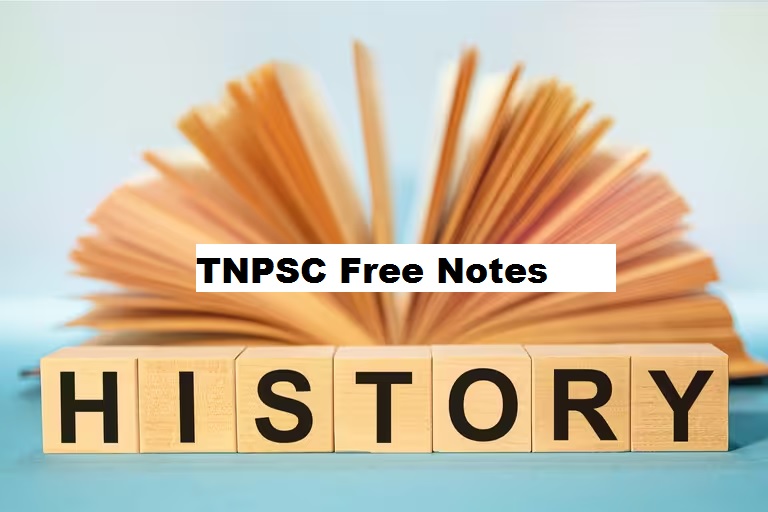இந்தக் கட்டுரையில், TNPSC குரூப் 1, குரூப் 2, குரூப் 2A, குரூப் 4 மாநிலப் போட்டித் தேர்வுகளான TNUSRB, TRB, TET, TNEB போன்றவற்றுக்கான முறைகள் இலவசக் குறிப்புகளைப் பெறுவீர்கள்.தேர்வுக்கு தயாராவோர் இங்குள்ள பாடக்குறிப்புகளை படித்து பயன்பெற வாழ்த்துகிறோம்.
Economy and Education of the Sultanate
Economy
After consolidating their position in India, the Delhi Sultans introduced reforms in the
land revenue administration.
The lands were classified into three categories:
iqta land – lands assigned to officials as iqtas instead of payment for their services.
khalisa land – land under the direct control of the Sultan and the revenues collected
were spent for the maintenance of royal court and royal household.
Inam land – land assigned or granted to religious leaders or religious institutions.
The peasantry paid one third of their produce as land revenue, and sometimes even one
half of the produce. They also paid other taxes and always led a hand-to mouth living.
Frequent famines made their lives more miserable.
However, Sultans like Muhammad bin Tughlaq and Firoz Tughlaq took efforts to
enhance agricultural production by providing irrigational facilities and by providing
takkavi loans. They also encouraged the farmers to cultivate superior crop like wheat
instead of barley.
Firoz encouraged the growth of horticulture. Muhammad bin Tughlaq created a
separate agricultural department, Diwani Kohi.
Firoz Shah Tughluq promoted agriculture by waiving off the debts of the agriculturalists
and constructing many canals for irrigation. He laid out 1200 new gardens and restored
30 old gardens of Ala-ud-din-Khalji.
During the Sultanate period, the process of urbanization gained momentum. A number
of cities and towns had grown during this period. Lahore, Multan, Broach, Anhilwara,
Laknauti, Daulatabad, Delhi and Jaunpur were important among them.
Delhi remained the largest city in the East. The growth of trade and commerce was
described by contemporary writers.
India exported a large number of commodities to the countries on the Persian Gulf and
West Asia and also to South East Asian countries.
Overseas trade was under the control of Multanis and Afghan Muslims. Inland trade was
dominated by the Gujarat Marwari merchants and Muslim Bohra merchants.
Construction of roads and their maintenance facilitated for smooth transport and
communication. Particularly the royal roads were kept in good shape.
Sarais or rest houses on the highways were maintained for the convenience of the
travelers.
Trade & Commerce
Cotton textile and silk industry flourished in this period. Sericulture was introduced on a
large scale which made India less dependent on other countries for the import of raw
silk.
Paper industry had grown and there was an extensive use of paper from 14 th and
15 th centuries.
Other crafts like leather-making, metal-crafts and carpet-weaving flourished due to the
increasing demand.
The royal karkhanas supplied the goods needed to the Sultan and his household. They
manufactured costly articles made of gold, silver and goldware.
The nobles also aped the lifestyle of Sultans and indulged in luxurious life. They were
well paid and accumulated enormous wealth.
The system of coinage had also developed during the Delhi Sultanate. Iltutmish issued
several types of silver tankas.
One silver tanka was divided into 48 jitals during the Khalji rule and 50 jitals during the
Tughlaq rule. Gold coins or dinars became popular during the reign of Alauddin Khalji
after his South Indian conquests.
Copper coins were less in number and dateless. Muhammad bin Tughlaq had
experimented not only token currency but also issued several types of gold and silver
coins.
They were minted at eight different places. At least twenty five varieties of gold coins
were issued by him.
Education
Certain traditions of education were now implanted from the Islamic World. At the base
was the maktab, where a schoolmaster taught children to read and write.
At a higher level, important texts in various subjects were read by individual pupils with
particular scholars who gave instruction (dars) in them.
A more institutionalised form of higher education, the madrasa, became widely
established in Central Asia and Iran in the eleventh century, and from there it spread to
other Islamic countries.
Usually the madrasa had a building, where instruction was given by individual teachers.
Often there was a provision of some cells for resident students, a library and a mosque.
Firoz Tugluq built a large madrasa at Delhi whose splendid building still stands. From
Barani’s description it would seem that teaching here was mainly confined to “Quran-
commentary, the Prophet’s sayings and the Muslim Law (fiqh).”
It is said that Sikander Lodi(1489–1517) appointed teachers in maktabs and madrasas in
various cities throughout his dominions, presumably making provision for them through
land or cash grants.
In addition to secular sciences that came with Arabic and Persian learning to India, one
more notable addition was systematic historiography.
Architecture and Literature of the Sultanate
Architecture
Arch, dome, vaults and use of lime cement, the striking Saracenic features, were
introduced in India. The use of marble, red, grey and yellow sandstones added grandeur
to the buildings.
In the beginning, the Sultans converted the existing buildings to suit their needs.
Qutb-ud-din Aibak’s Quwwat-ul-Islam mosque situated adjacent to Qutb Minar in Delhi
and the Adhai din ka Jhopra in Ajmer illustrate these examples.
A Hindu temple built over a Jain temple was modified into Quwwat-ul-Islam mosque.
Adhai din ka Jhopra was earlier a Jain monastery before being converted as a mosque.
With the arrival of artisans from West Asia the arch and dome began to show up with
precision and perfection. Gradually local artisans also acquired the skill.
The tomb of Balban was adorned with the first true arch and the Alai Darwaza built by
Ala-ud-din Khalji as a gateway to the Quwwat-ul-Islam Mosque is adorned with the first
true dome.
The palace fortress built by Ghiyasuddin Tughlaq and Muhammad bin Tughlaq in
Tughlaqabad, their capital city in Delhi, is remarkable for creating an artificial lake
around the fortress by blocking the river Yamuna.
The tomb of Ghiyasuddin Tughlaq introduced the system of sloping walls bearing the
dome on a raised platform.
The buildings of Firuz Tughlaq, especially his pleasure resort, Hauz Khas, combined
Indian and Saracenic features in alternate storeys, displaying a sense of integration.
Music and Dance
Music was an area where the syncretic tendencies were clearly visible.
Muslims brought their musical instruments like Rabab and Sarangi.
Amir Khusrau proclaimed that Indian music had a pre-eminence over all the other music
of the world.
The Sufi practice of Sama, recitation of love poetry to the accompaniment of music, was
instrumental in promotion of music.
Pir Bhodan, a Sufi saint, was considered a great musician of the age. Royal patronage for
the growth of music was also forthcoming.
Firuz Tughlaq evinced interest in music leading to synchronisation by translating an
Indian Sanskrit musical work Rag Darpan into Persian.
Dancing also received an impetus in the official court.
Zia-ud-din Barani lists the names of Nusrat Khatun and Mihr Afroz as musician and
dancer respectively in the court of Jalaluddin Khalji.
Literature
Amir Khusrau emerged as a major figure of Persian prose and poetry.
Amir Khusrau felt elated to call himself an Indian in his Nu Siphr(‘Nine Skies’). In this
work, he praises India’s climate, its languages – notably Sanskrit – its arts, its music, its
people, even its animals.
The Islamic Sufi saints made a deep literary impact. The Fawai’d-ul-Fawad, a work
containing the conversations of Sufi Saint Nizam-ud-din, Auliya was compiled by Amir
Hassan.
A strong school of historical writing emerged with the writings of Zia-ud-din Barani,
Shams-ud-din Siraj Afif and Abdul Malik Isami. Zia-ud-din Barani, emerged as a master of
Persian prose.
Abdul Malik Isami, in his poetic composition of Futuh-us-Salatin, records the history of
Muslim rule.
Persian literature was enriched by the translation of Sanskrit works. Persian dictionaries
with appropriate Hindawi words for Persian words were composed, the most important
being Farhang-i-Qawas by Fakhr-ud-din Qawwas and Miftah-ul-Fuazala by Muhammad
Shadiabadi.
Bengali literature had also developed and Nusrat Shah patronized the translation of
Mahabaratha into Bengali.
The Bakthi cult led to the development of Gujarati and Marathi languages. The
Vijayanagar Empire patronised Telugu and Kannada literature.
**************************************************************************
| Adda247 TamilNadu Home page | Click here |
| Official Website=Adda247 | Click here |




